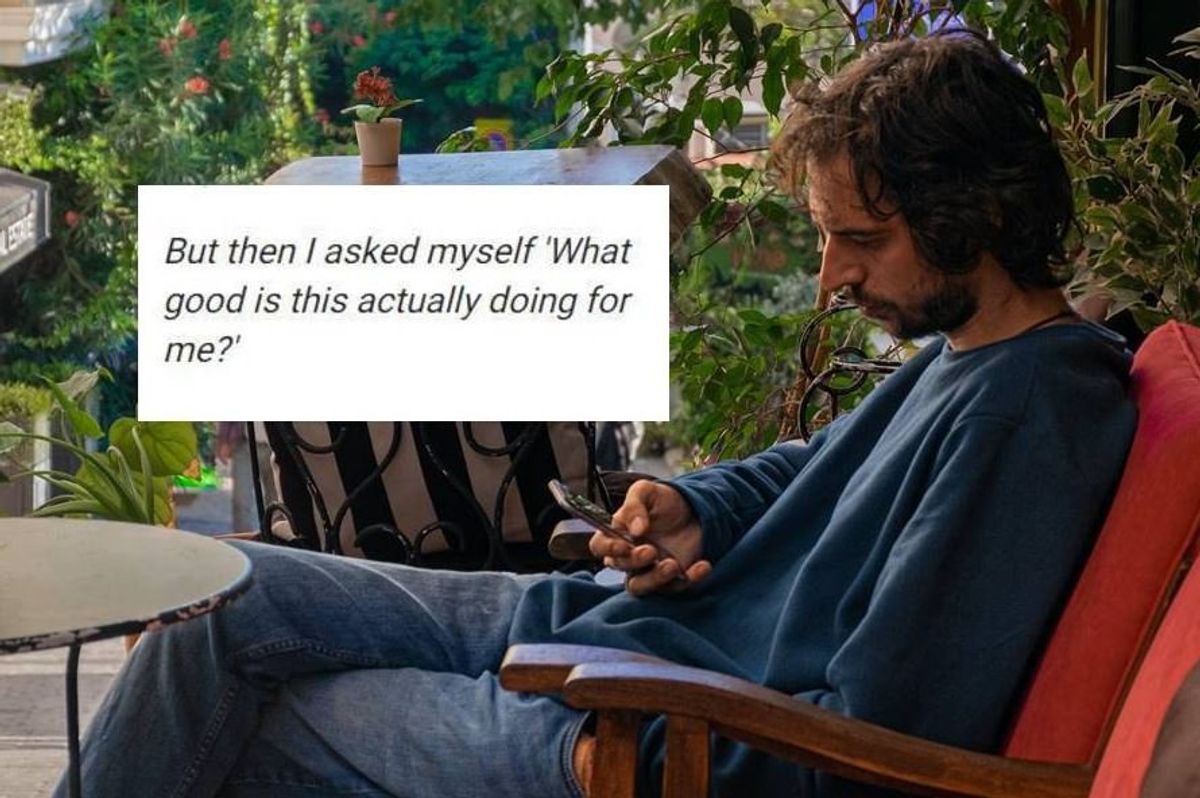'Recovering Doomscroller' shares how he was able to break his news 'addiction' in revealing post
He was scrolling through the news during dinner with his family and knew he had to stop.

A man sits in his chair apathetically scrolling through social media.
Keeping up with the 24-hour news cycle in real time can be overwhelming. It can lead to a negative cycle known as “doomscrolling,” or endlessly scrolling through negative news, usually without realizing the emotional impact it's having.
Doomscrollers can get fixated on various topics, such as politics, crime, social justice, celebrity news, and even the personal lives of people they know on social media.
A Reddit user named Max wrote a revealing post about his doomscrolling habit on the Taoism subreddit. It explained how he got wrapped up in the vicious cycle, how it affected him on a biochemical level, and how he freed himself from the addiction. Taoism is a 1,900-year-old philosophy developed in China centered around balance, harmony with nature, simplicity and spontaneity.
Max started his post like he was speaking at an Alcoholics Anonymous meeting.
"I used to spend long nights refreshing the news sites. I'd open my browser looking for a hit of dopamine, something to be hopeful and happy about, but all the bad news only gave me a buzz of adrenaline (a survival hormone) and cortisol (a stress hormone.) But what's worse, when the adrenaline and cortisol wore off, I'd go in and re-dose.Not only can doomscrolling be addictive, but the fight or flight response also shuts down our thinking brain … so when doomscrolling sets off the fight or flight response, it also turns off a lot of our higher thinking and reasoning. It sends us panicking when we should be planning.
I told myself I was just staying informed. That's how it started. But then I couldn't look away. It's like I had to know what was happening, y'know? 'If I don't check the news the world will burn.' It got to the point where I was doomscrolling at work, and at family dinner, in my free time, and I started feeling distraught and depressed."
Max’s description of the biochemical impacts of doomscrolling is backed up by science. “Information-seeking is a distinctly human trait, encouraged by neurochemical reactions. When our curiosity is piqued, the sense of discovery releases hits of dopamine in the brain, triggering the reward system, which in turn encourages us to explore a topic, knowledge, or question even further,” Jeffrey Davis writes in Psychology Today.
Susanne Babbel, a psychotherapist specializing in trauma recovery, told CNN that when we hear bad news, we go into “stress mode” and our bodies release “hormones like cortisol and adrenaline” that can put us in a fight-or-flight response.
Dr. Karin Gepp supports the claim that when we go into fight or flight mode, it deactivates "the part of your brain responsible for rational, logical thinking."
Max realized that his constant doomscrolling wasn’t helping anyone.
"But then I asked myself 'What good is this actually doing for me? I already vote, I already campaign and donate, I already advocate for solutions, and I already try to be part of the solution in my daily life.' Doomscrolling wasn't making me more engaged, it was making me more depressed, and being depressed, and scared, and stressed, only made it more difficult to address my problems and the problems of others."
Max believes his new focus on action over attention has helped him exit the vicious cycle of doomscrolling. He used climate change as an example:
"Voting to protect the environment is good; having panic attacks because your desktop wallpaper is a live feed of the ice caps melting is not good. If you're already voting, you don't need to keep watching the video."
Humans are incredibly complex beings, and it can be tough to grasp that the things we think are helping ourselves and others may sometimes be causing everyone more harm. But it seems Max has come to a healthy bottom line that anyone who uses social media can take to heart: We only have so much time, and we should spend more of it working on solving problems than indulgently wallowing in them.
- Indian village takes a digital siesta for a few hours every day so that people talk to each other ›
- Jennifer Garner explains the simple, empowering way she keeps her teens off social media ›
- A compelling theory on why social media promises fun but ultimately leaves us bored and listless ›
- Is social media 'killing the real you'? - Upworthy ›

